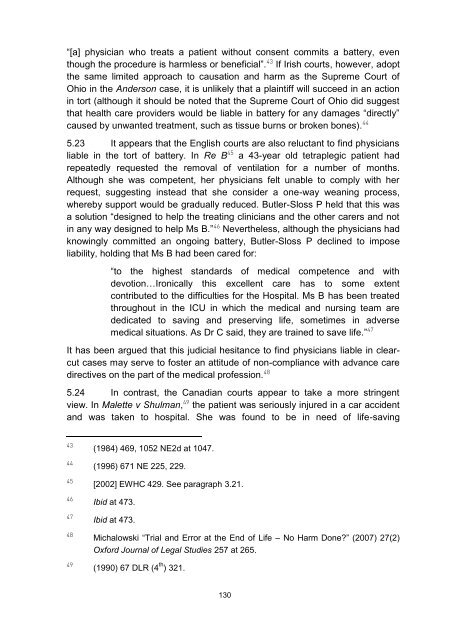Consultation Paper on Bioethics - Law Reform Commission
Consultation Paper on Bioethics - Law Reform Commission
Consultation Paper on Bioethics - Law Reform Commission
Create successful ePaper yourself
Turn your PDF publications into a flip-book with our unique Google optimized e-Paper software.
“[a] physician who treats a patient without c<strong>on</strong>sent commits a battery, even<br />
though the procedure is harmless or beneficial”. 43 If Irish courts, however, adopt<br />
the same limited approach to causati<strong>on</strong> and harm as the Supreme Court of<br />
Ohio in the Anders<strong>on</strong> case, it is unlikely that a plaintiff will succeed in an acti<strong>on</strong><br />
in tort (although it should be noted that the Supreme Court of Ohio did suggest<br />
that health care providers would be liable in battery for any damages “directly”<br />
caused by unwanted treatment, such as tissue burns or broken b<strong>on</strong>es). 44<br />
5.23 It appears that the English courts are also reluctant to find physicians<br />
liable in the tort of battery. In Re B 45 a 43-year old tetraplegic patient had<br />
repeatedly requested the removal of ventilati<strong>on</strong> for a number of m<strong>on</strong>ths.<br />
Although she was competent, her physicians felt unable to comply with her<br />
request, suggesting instead that she c<strong>on</strong>sider a <strong>on</strong>e-way weaning process,<br />
whereby support would be gradually reduced. Butler-Sloss P held that this was<br />
a soluti<strong>on</strong> “designed to help the treating clinicians and the other carers and not<br />
in any way designed to help Ms B.” 46 Nevertheless, although the physicians had<br />
knowingly committed an <strong>on</strong>going battery, Butler-Sloss P declined to impose<br />
liability, holding that Ms B had been cared for:<br />
“to the highest standards of medical competence and with<br />
devoti<strong>on</strong>…Ir<strong>on</strong>ically this excellent care has to some extent<br />
c<strong>on</strong>tributed to the difficulties for the Hospital. Ms B has been treated<br />
throughout in the ICU in which the medical and nursing team are<br />
dedicated to saving and preserving life, sometimes in adverse<br />
medical situati<strong>on</strong>s. As Dr C said, they are trained to save life.” 47<br />
It has been argued that this judicial hesitance to find physicians liable in clearcut<br />
cases may serve to foster an attitude of n<strong>on</strong>-compliance with advance care<br />
directives <strong>on</strong> the part of the medical professi<strong>on</strong>. 48<br />
5.24 In c<strong>on</strong>trast, the Canadian courts appear to take a more stringent<br />
view. In Malette v Shulman, 49 the patient was seriously injured in a car accident<br />
and was taken to hospital. She was found to be in need of life-saving<br />
43 (1984) 469, 1052 NE2d at 1047.<br />
44 (1996) 671 NE 225, 229.<br />
45 [2002] EWHC 429. See paragraph 3.21.<br />
46 Ibid at 473.<br />
47 Ibid at 473.<br />
48 Michalowski “Trial and Error at the End of Life – No Harm D<strong>on</strong>e?” (2007) 27(2)<br />
Oxford Journal of Legal Studies 257 at 265.<br />
49 (1990) 67 DLR (4 th ) 321.<br />
130

















